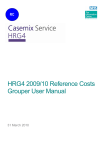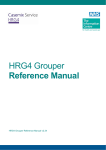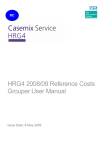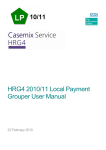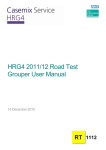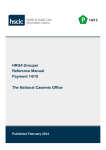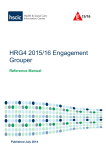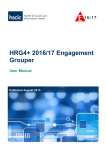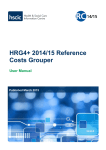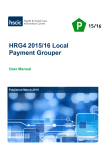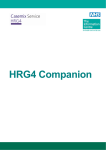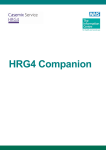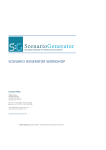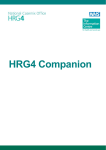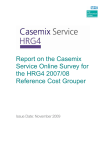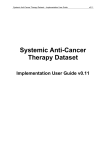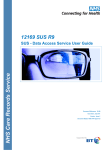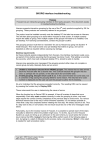Download HRG4 Grouper Reference Manual v3.0
Transcript
HRG4 Grouper Reference Manual HRG4 Grouper Reference Manual v3.0 The Health and Social Care Information Centre is England’s central, authoritative source of health and social care information The National Casemix Office designs and refines classifications that are used by the NHS in England to describe healthcare activity Health and Social Care Information Centre www.ic.nhs.uk 0845 300 6016 [email protected] National Casemix Office www.ic.nhs.uk/casemix Glossary of Terms www.ic.nhs.uk/jargon-buster Department of Health - Payment by Results www.dh.gov.uk/pbr NHS Connecting for Health www.cfh.nhs.uk Contents 1 Quick Start 1.1 Download and Install the Grouper 1.2 Grouping Walkthrough Using Sample Data 2 Grouping Your Own Data 3 Record Definition File (RDF) 3.1 Using the Record Definition File Wizard to Create a Custom RDF 3.2 Record Definition File Editor 4 Command Line Initiation 5 Secondary Uses Service Grouping 6 Additional Features 6.1 Single Spell Grouping 6.2 The Internal File Viewer 6.3 Grouper Priority 1 1 1 4 5 5 6 8 9 10 10 10 11 Annex A Input File Preparation A1 Admitted Patient Care A2 Non-Admitted Consultations A3 Emergency Medicine A4 Renal Dialysis (National Renal Dataset) A5 Adult Critical Care A6 Paediatric Critical Care A7 Neonatal Critical Care 1 1 3 4 5 6 7 8 Annex B Output Files B1 Admitted Patient Care B2 Non-Admitted Consultations B3 Emergency Medicine B4 Renal Dialysis (National Renal Dataset) B5 Adult Critical Care B6 Paediatric Critical Care B7 Neonatal Critical Care 1 2 8 10 12 14 16 18 Annex C Reference Costs Reports C1 Admitted Patient Care Episode Reports C2 Admitted Patient Care Spell Reports C3 Non-Admitted Care Reports C4 Emergency Medicine Reports C5 Adult Critical Care Reports 1 2 5 7 7 7 Annex D Errors 1 HRG4 Grouper Reference Manual v3.0 1 Quick Start This section is intended to provide a brief overview of downloading, installing and starting to use the HRG4 Grouper application. For more detailed information, you are advised to read the whole manual. 1.1 Download and Install the Grouper 1) Go here www.ic.nhs.uk/casemix/downloads. 2) Click on either Payment or Costing for the type of the grouper you need. Older versions are in the archives. 3) For payment groupers, there may be more than one version available; pick the version you need. 4) Click on the Grouper application link in the Download section at the right of the screen. 5) Save the Zip file to an appropriate location on your computer. 6) Open the Zip file and extract the Grouper application. 7) Double-click the Grouper application file and follow the installation setup wizard. 1.2 Grouping Walkthrough Using Sample Data The following walkthrough describes the process of grouping a sample Admitted Patient Care (APC) input file, available from the Casemix website. 1) Download the sample APC input file from the bottom of this page: www.ic.nhs.uk/hrg4groupermanual. 2) Open the Grouper application. 3) Select Admitted Patient Care HRG4 in the Database drop-down list. Other grouping types available can be seen in the drop down. 4) Click the Browse… button next to the Record Definition File (RDF) drop-down list. Copyright © 2013, Health and Social Care Information Centre. All Rights Reserved. 1 HRG4 Grouper Reference Manual v3.0 5) In the ‘Open’ form, browse for the Sample RDF. The sample RDFs are located in the Grouper’s installation folder. 6) Open the file ‘HRG4_sample_APC.rdf’. An alternative sample RDF file should be used for other grouping database selections. The database selection and RDF file should match. 7) From the Tools menu select Process File… 8) Click the browse button (folder icon) to the right of the Input File field. 9) In the ‘Open’ form, browse to and select the downloaded sample input file. 10) Click Open. 11) Ensure that the Input data has headings box is checked. 12) Click the browse button (folder icon) next to the Output File field. 13) In the ‘Save As’ form, browse to the folder containing the input file and type ‘output’ (or anything similarly appropriate) in the File name box. 14) Click Save. The path and filename of the output file are displayed in the Output File field. Copyright © 2013, Health and Social Care Information Centre. All Rights Reserved. 2 HRG4 Grouper Reference Manual v3.0 15) Ensure that the Add headings to output data box is checked. 16) Click the Process button. When finished, the log display area shows information about the grouping session, including the number of records grouped. These details can also be found in the file hrg.log in the grouper directory. 17) Open Windows Explorer and browse to the folder specified for the output file. 18) Open the file ‘output_FCE.csv’ in Microsoft Excel. The file is a copy of the input file with HRGs and other related columns appended. Other output files are explained in Annex B. 19) Scroll to the far-right of the file to view the columns that the Grouper has appended. Copyright © 2013, Health and Social Care Information Centre. All Rights Reserved. 3 HRG4 Grouper Reference Manual v3.0 2 Grouping Your Own Data In order to group your own data you need to either: 1. Ensure that the structure of your data is identical to that as specified in an existing RDF file, or 2. Create an RDF file (see Section 3) that matches the structure of your data. Grouping can be initiated from the front end, as shown in the quick start section, or from the command line – see Section 4. Whichever approach is used the same input rules (Annex A), grouper processing and output file structures and content (Annex B) will result. Another approach for single records and for single APC multi-episode spells is to use the Single Spell Grouper (Menu - Tools/Single Spell). To get an initial appreciation of grouping you are recommended to experiment with the Single Spell Grouper functionality. Copyright © 2013, Health and Social Care Information Centre. All Rights Reserved. 4 HRG4 Grouper Reference Manual v3.0 3 Record Definition File (RDF) The RDF file tells the grouper the structure of the data you want it to process. The field content of the RDF file must include all mandatory input fields (see Annex A) for the type of data you want to group. Although these fields are mandatory, you define their order. You can also include additional fields, which will be ignored by the grouper. The easiest way to create an RDF is to use the Wizard. 3.1 Using the Record Definition File Wizard to Create a Custom RDF Select ‘New RDF’ from the ‘File’ menu Select required Database (the type of input file with which the RDF will be used) Select Data Definition Method (The method by which the RDF will be created). Two data definition methods are available, these are: • Create fields manually. This method uses a grid to define field positions and attributes. Selecting this option and clicking the ‘Next’ button opens the RDF editor grid where the fields can be manually defined. • Create from a sample file (Default). This method guides the interactive creation of an RDF using a sample input file. Select the option and click Next. You will be prompted for an input file. When a file has been selected the field selection form is displayed. The first row of the selected input file is shown in the preview area in the lower part of the form. At this stage each field is assigned a temporary field name (e.g. ‘Field 1’, ‘Field 2’). Copyright © 2013, Health and Social Care Information Centre. All Rights Reserved. 5 HRG4 Grouper Reference Manual v3.0 Depending on the data type, the number of repeating occurrences of certain fields can be increased. For example, if the input file contains 20 diagnosis codes, the value in Number of diagnosis codes should be set to 20 rather than the default value of 14. All field names in the Mandatory Fields list must be assigned to fields in the sample input file. Fields are assigned by using the mouse to drag the field name from the list to the appropriate field in the preview area. Fields move from the Mandatory Fields list to the Assigned Fields list as they are assigned. Multiple fields can be selected by clicking with the mouse while holding down the SHIFT and/or CTRL keys. The selected fields can then be dragged to the preview area. If a field is erroneously assigned, it can be removed by selecting it in the Assigned Fields list and pressing the Delete key. The field will then appear at the bottom of the Mandatory Fields list. When all fields have been assigned, click OK to proceed. The RDF will be opened in the RDF editor (see next section), allowing checking and any required amendments. Alternatively, just save the new RDF file ready for use (File/Save As). 3.2 Record Definition File Editor Selecting Open RDF from the File menu prompts you to select a record definition file and opens it for editing. The editor allows you to modify of field positions and field attributes in an RDF. The RDF columns are: Name Field Name Field Title Field No Picture Extract Description A field name abbreviation for internal use; it cannot be modified. A field description which can be edited to display a locally-defined field name. The field column number in the input file. Specifies whether specific character positions in the field are used or ignored during processing. For example: “AAA.A” (in which “A” means keep the character in that position. “.” Means remove the character in that position [all without quote marks].) Allows you to specify that specific characters (in any position) in the field are ignored during processing. (e.g. “.” Without quote marks will remove full stops from the field) The Insert toolbar button inserts a new field in the RDF. This feature is provided so that non-mandatory fields can be shown using the Display File feature. For the purposes of grouping, it is Copyright © 2013, Health and Social Care Information Centre. All Rights Reserved. 6 HRG4 Grouper Reference Manual v3.0 not necessary for the RDF to specify the positions of all fields in the input file. Only mandatory fields need to be specified. The Delete toolbar button removes a non-mandatory field from the RDF. Mandatory fields cannot be deleted. When you save the RDF, you will be informed of any validation checks that have been failed, e.g. conflicting field positions. Validation issues must be resolved before the file can be saved. Copyright © 2013, Health and Social Care Information Centre. All Rights Reserved. 7 HRG4 Grouper Reference Manual v3.0 4 Command Line Initiation ‘Command line’ refers to the character-based command shell user interface within Microsoft Windows, commonly known as the DOS Window. The Grouper can process a file using the command line with parameters shown below. Mandatory parameters are enclosed within <angle brackets>; optional parameters are enclosed within [square brackets]. All parameters consist of a hyphen followed by a lower-case letter. The command line takes the following form: HRGGrouper -i<Input File> -o<Output File> -d<Record Definition File> -l<Grouping Logic> [-h] [-t] [-p] [-r<report filename>] Command line parameters: -i The path and filename of the input file. -o The path and filename of the output file. -d The path and filename of the record definition file. -l The grouping logic – a filename from the grouper directory that has the extension “.tre”. This is the equivalent of picking the database in the GUI. -h Optional. Where present, indicates that the input file has a header row (field names). Omit this parameter where the first row in the file is a data row. -t Optional. Where present, stops generation of field names in the top row of output file. If this parameter is omitted then each of the output files will contain a header row. -p Optional. Where present, sets the priority of the grouping process. The available values are 1, 2 and 3. 1=’Normal’ (Grouper priority equal to that of other applications), 2=’Lower’ (Grouper yields to other applications), 3=’Idle’ (Grouper only processes data when other applications don’t require processor time). If this parameter is omitted, the priority is set to 1 (‘Normal’). -r Valid in Reference Costs Grouper only. Optional. Where present, specifies one of the built-in reports (see list in reports section below). The -r flag can be repeated to specify the production of more than one report. The report names are the filenames of .rgf files supplied as part of the Grouper installation. See the Reports Annex of this document for further information about the available reports. If this parameter is omitted, reports are not produced. -? Optional. Where present, directs the Grouper to list the available command line parameters to the hrg.log file in the Grouper program folder. This parameter cannot be combined with other parameters. Where there are spaces in paths or filenames for parameter values, the parameter value must be enclosed within double-quote characters. An example script using the command line is: @echo off C: cd "Program Files\HSCIC\#grouperFolderName#" HRGGrouper -i "C:\HRG Data\apc100.CSV" -o "C:\HRG Data\output.csv" -d "HRG4_sample_APC.rdf" -l #groupingLogic.tre# -h -p 3 -r APCFCEReport001.rgf -r APCFCEReport002.rgf IF %ERRORLEVEL% NEQ 0 echo Error in command, please check hrg.log Pause Copyright © 2013, Health and Social Care Information Centre. All Rights Reserved. 8 HRG4 Grouper Reference Manual v3.0 5 Secondary Uses Service Grouping The results of grouping the same data in SUS or in the corresponding local payment grouper are always the same; there is no difference in the grouping engine. Any apparent differences between your grouping of data and that in SUS are likely to be caused by: • • • Exclusions. Some episodes are excluded from spells according to DH rules. Lack of such records in a spell can affect the spell level grouping results. To get the same result you may need to remove excluded episodes from the grouping run. Critical Care Days calculations. The SUS derivation of critical care days is much more comprehensive than documented here. It also includes a number of validation checks that could result in a slightly different number of CC days being applied which could affect grouping. Spell Construction. The local grouper uses the contents of the Provider Code and the Hospital Provider Spell Number fields to ensure FCEs in the spell are grouped together. SUS derives its own spell identifier and uses that in place of the Hospital Provider Spell Number. This can mean that different sets of episodes are treated as part of a spell (in reality there are few such differences). In non-admitted care, SUS can produce two HRGs. This can occur when the derived HRG is not tariffed. An attendance HRG is calculated by a means equivalent to grouping after removal of all procedures except those starting with “X62”. In emergency medicine, SUS produces a dummy HRG “DOA” from which a tariff is derived if the A AND E Patient Group contains value “70” meaning “Brought in dead”. For local grouping, you are expected to group the appropriate sub-sets of ACC, NCC and PCC separately and treat their results as un-bundled HRGs as a part of the parent episode/spell. This is necessary because of the difficulties expected for many users when dealing with more complex relational input. SUS groups the combination of APC, ACC, NCC and PCC simultaneously. Copyright © 2013, Health and Social Care Information Centre. All Rights Reserved. 9 HRG4 Grouper Reference Manual v3.0 6 Additional Features 6.1 Single Spell Grouping Selecting Single Spell… from the Tools menu opens the Single Spell Grouping form. Single spell grouping enables the grouping of manually input data. This can be useful when exploring how certain combinations of clinical codes lead to different HRGs being derived. A database and a matching RDF must be selected in the Grouper’s main screen. The window is divided into 3 sections: The top section is where you enter values for fields. Some have been pre-populated with commonly used / generic values but they can be changed. For APC, if you want to record multiple episodes press “Click to add record”. This can be done more than once but you may need to resize the window. Again, some fields are prepopulated – normally with values given in record 1. The middle section will show grouping results fields after you have pressed the “Group” button. The bottom section will show any error messages that would appear in the quality when grouping a file. 6.2 The Internal File Viewer The Grouper provides a file viewer which can be used to view Grouper output files. To access the file viewer, select Display File... from the Tools menu. This opens an open file box. To display output files in the file list ensure that the Files of type drop-down list is set to “*.inp,*.out,*.csv,*.txt” When a file is opened, the fields displayed are restricted to those defined in the RDF that is currently active. This means that in order to use the Display File feature to view the columns that grouping appends during file processing, an RDF must be created that includes those fields. Double-clicking on a record within the display opens it in the Single Spell Grouping screen. Copyright © 2013, Health and Social Care Information Centre. All Rights Reserved. 10 HRG4 Grouper Reference Manual v3.0 6.3 Grouper Priority The grouping process can use a large amount of processor resource. On some computers this can make other applications slow or unresponsive during grouping. To reduce impact on other applications the Grouper’s priority can be set using the radio buttons while the progress bar is displayed during file processing. Setting Normal Lower Idle Effect Gives the Grouper the same priority as other applications, other applications may be slowed down while the Grouper is running. Reduces processor utilisation and gives priority to other applications. Minimises the Grouper’s use of processing resources. The Grouper will only process data when no other applications require processing resources. Priority can be changed for the current grouping run only, each time a file is processed Priority will automatically be set to Normal. The Priority options on the progress bar provide a shortcut to the thread priority settings in the Windows Task Manager. In Windows Task Manager, the same effect can be achieved by setting the grouping process (HRGGrouper.exe) priority to ‘Normal’, ‘BelowNormal’ or ‘Low’. Where the Grouper is run from the command line, the progress bar is not displayed thus there is no access to the Priority radio buttons. To set the priority for a grouping process run from the command line, use –p command line parameter or the Windows Task Manager as described above. Warning: the grouping process priority should not be set higher than ‘Normal’ in Windows Task Manager. Setting the grouping process priority above ‘Normal’ might prevent Windows system services from running and could destabilise the system. Copyright © 2013, Health and Social Care Information Centre. All Rights Reserved. 11 HRG4 Grouper Reference Manual v3.0 Annex A Input File Preparation This annex provides guidance about preparing input files for processing with the Grouper. Note: Unless otherwise stated, the values in each field are validated against enumerated sets of values – generally based on NHS Data Dictionary definitions. File Format: Input data must be in comma-separated value (CSV) format using the standard American Standard Code for Information Interchange (ASCII) character set, excluding the non-printing ASCII characters. The input file must not include qualifiers, such as quotes, surrounding the fields. Using Excel for File Preparation: If some of the records end with empty fields then a file structure issue can arise when saving a text file using Microsoft Excel (for more information please refer to Microsoft Article ID 77295 “Column delimiters are missing in an Excel spreadsheet that is saved as text” [http://support.microsoft.com/default.aspx?scid=77295]). To prevent this issue arising, ensure that the final (rightmost) column of data is populated for every record in the file with ‘dummy data’ such as “x”. A1 Admitted Patient Care The Grouper sorts APC data prior to processing so that records with the same Provider Code and Provider Spell Number are placed in Episode Number order. Grouper Field Name CDS/DD Field Name Notes PROCODET ORGANISATION CODE (CODE OF PROVIDER) A value must be supplied but is not validated. For NHS organisations use the first 3 characters for non-NHS organisations use all 5 characters. PROVSPNO HOSPITAL PROVIDER SPELL NUMBER A value must be supplied but is not validated. Maximum length 24 characters. EPISODE NUMBER A value must be supplied but is not validated. Duplicates within a spell will create an error. STARTAGE Derived Whole years rounded down: START DATE (EPISODE) - PERSON BIRTH DATE SEX PERSON GENDER CODE CURRENT Must be same for all episodes in a Spell. CLASSPAT PATIENT CLASSIFICATION CODE Must be the same for all episodes within a Spell. ADMISORC SOURCE OF ADMISSION CODE (HOSPITAL PROVIDER SPELL) Must be the same for all episodes within a Spell. ADMIMETH ADMISSION METHOD CODE (HOSPITAL PROVIDER SPELL) Must be the same for all episodes within a Spell. EPIORDER Copyright © 2013, Health and Social Care Information Centre. All Rights Reserved. A-1 HRG4 Grouper Reference Manual v3.0 Grouper Field Name CDS/DD Field Name Notes DISDEST DISCHARGE DESTINATION CODE (HOSPITAL PROVIDER SPELL) Make sure this is properly populated, at least for the last episode in the spell. DISMETH DISCHARGE METHOD CODE (HOSPITAL PROVIDER SPELL) Make sure this is properly populated, at least for the last episode in the spell. EPIDUR Derived Range: 0-99999. Whole days: END DATE (EPISODE) – START DATE (EPISODE) MAINSPEF CARE PROFESSIONAL MAIN SPECIALTY CODE NEOCARE NEONATAL LEVEL OF CARE CODE TRETSPEF ACTIVITY TREATMENT FUNCTION CODE DIAG_01 PRIMARY DIAGNOSIS (ICD) May be blank. Valid ICD-10 code (excluding decimal point character and any dagger/asterisk suffix). If this field is blank an error will be generated. SECONDARY DIAGNOSIS (ICD) DIAG_02 - DIAG_99 OPER_01 - OPER_99 As above, but blank allowed. PRIMARY PROCEDURE (OPCS) and PROCEDURE (OPCS) Valid OPCS-4 codes (excluding decimal point character) or blank. CRITICAL CAREDAYS Derived Count of distinct days within the episode when the patient was in Critical Care. If the patient was in Critical Care on the last day of an episode that was not the last episode of the spell, assign that day to the next episode. REHABILITATION DAYS LENGTH OF STAY ADJUSTMENT (REHABILITATION) Range: 0-99999 or blank. Non-numeric characters treated as zero. SPCDAYS LENGTH OF STAY ADJUSTMENT (SPECIALIST PALLIATIVE CARE) Range: 0-99999 or blank. Non-numeric characters treated as zero. Copyright © 2013, Health and Social Care Information Centre. All Rights Reserved. A-2 HRG4 Grouper Reference Manual v3.0 A2 Non-Admitted Consultations Non-admitted Consultations are outpatient attendances or attendances by patients for nursing care on a ward (ward attenders). Since April 1st 2005 the Outpatient Attendance CDS has contained both of these types of data. The field list below shows the fields required by the Grouper. The field order of the input file is defined by the Record Definition File used for the grouping session; there is no significance to the order in which the fields are listed below. Grouper Field name CDS/DD Field Name Notes STARTAGE Derived Whole years rounded down: APPOINTMENT DATE - PERSON BIRTH DATE SEX PERSON GENDER CODE CURRENT MAINSPEF CARE PROFESSIONAL MAIN SPECIALTY CODE TRETSPEF ACTIVITY TREATMENT FUNCTION CODE FIRSTATT FIRST ATTENDANCE CODE OPER_01 - OPER_99 PRIMARY PROCEDURE (OPCS) and PROCEDURE (OPCS) Valid OPCS-4 codes (excluding decimal point character) or blank. Each row of the input file represents a single attendance. Diagnosis Codes Diagnostic coding is excluded from the HRG4 algorithm for non-admitted care. Copyright © 2013, Health and Social Care Information Centre. All Rights Reserved. A-3 HRG4 Grouper Reference Manual v3.0 A3 Emergency Medicine The field list below shows the fields required by the Grouper. The field order of the input file is defined by the Record Definition File used for the grouping session; there is no significance to the order in which the fields are listed below. Grouper Field Name AGE CDS/DD Field Name Notes Derived Whole years rounded down: ARRIVAL DATE - PERSON BIRTH DATE Validated, but not used in grouping. INV_01 - INV_99 ACCIDENT AND EMERGENCY INVESTIGATION – FIRST and ACCIDENT AND EMERGENCY INVESTIGATION - SECOND Valid national code component (always 2 characters) or blank. The “Local Sub-Analysis” part should not be submitted. Leading zeroes must be included where they form part of the national code component. TREAT_01 - TREAT_99 ACCIDENT AND EMERGENCY TREATMENT – FIRST and ACCIDENT AND EMERGENCY TREATMENT - SECOND Valid national code component (2 or 3 characters) or blank. The “Local Sub-Analysis” part should not be submitted. Leading zeroes must be included where they form part of the national code component. Each row of the input file represents one Accident and Emergency Attendance. Copyright © 2013, Health and Social Care Information Centre. All Rights Reserved. A-4 HRG4 Grouper Reference Manual v3.0 A4 Renal Dialysis (National Renal Dataset) Renal Dialysis HRGs are generated using fields from the National Renal Dataset. The field list below shows the fields required by the Grouper. The field order of the input file is defined by the Record Definition File used for the grouping session; there is no significance to the order in which the fields are listed below. Grouper Field Name DD Field Name Notes RENALMOD RENAL TREATMENT MODALITY Leading zeros are significant. CODE RENALSITE RENAL TREATMENT PRIMARY SUPERVISION CODE Leading zeros are significant. RENALACCESS RENAL DIALYSIS ACCESS TYPE Leading zeros are significant. HBV HEPATITIS B ANTIGEN STATUS (RENAL CARE) Must be UPPER CASE. Accepted values are NEG, POS and UNK. HCV HEPATITIS C ANTIBODY STATUS (RENAL CARE) Must be UPPER CASE. Accepted values are NEG, POS and UNK. HIV HUMAN IMMUNODEFICIENCY VIRUS STATUS (RENAL CARE) Must be UPPER CASE. Accepted values are NEG, POS and UNK. AGE Derived The age of the patient in whole years at the start date of the session. Range: 0 – 130. Each row of the input file represents either one haemodialysis session or one day of peritoneal dialysis. Copyright © 2013, Health and Social Care Information Centre. All Rights Reserved. A-5 HRG4 Grouper Reference Manual v3.0 A5 Adult Critical Care Please see the bottom of Section 5 for a comment about critical care grouping. The field list below shows the fields required by the Grouper. The field order of the input file is defined by the Record Definition File used for the grouping session; there is no significance to the order in which the fields are listed below. Grouper Field Name CDS/DD Field Name Notes CCUF CRITICAL CARE UNIT FUNCTION Leading zeros are significant. BCSD BASIC CARDIOVASCULAR SUPPORT DAYS Range: 0 – 99999. ACSD ADVANCED CARDIOVASCULAR Range: 0 – 99999. SUPPORT DAYS BRSD BASIC RESPIRATORY SUPPORT DAYS Range: 0 – 99999. ARSD ADVANCED RESPIRATORY SUPPORT DAYS Range: 0 – 99999. RSD RENAL SUPPORT DAYS Range: 0 – 99999. NSD NEUROLOGICAL SUPPORT DAYS Range: 0 – 99999. DSD DERMATOLOGICAL SUPPORT DAYS Range: 0 – 99999. LSD LIVER SUPPORT DAYS Range: 0 – 99999. CCL2D CRITICAL CARE LEVEL 2 DAYS Range: 0 – 99999. CCL3D CRITICAL CARE LEVEL 3 DAYS Range: 0 – 99999. CC_Start_Date CRITICAL CARE START DATE Format is CCYYMMDD. e.g. 14 March 2009 = 20090314. CC_Discharge_Date CRITICAL CARE DISCHARGE DATE Format is CCYYMMDD. e.g. 14 March 2009 = 20090314. Critical Care Start Date and Critical Care Discharge Date fields are used to calculate critical care days in the Grouper output file. They are not used in HRG derivation. Each row of the input file represents one Adult Critical Care Period. Copyright © 2013, Health and Social Care Information Centre. All Rights Reserved. A-6 HRG4 Grouper Reference Manual v3.0 A6 Paediatric Critical Care Please see the bottom of Section 5 for a comment about critical care grouping. The Grouper sorts Paediatric Critical Care data prior to grouping so that records with the same provider code and local identifier are placed in activity date order. The field list below shows the fields required by the Grouper. The field order of the input file is defined by the Record Definition File used for the grouping session; there is no significance to the order in which the fields are listed below. Grouper Field Name CDS/DD Field Name Notes PROCODET ORGANISATION CODE (CODE OF PROVIDER) A value must be supplied but is not validated. For NHS organisations use the first 3 characters for non-NHS organisations use all 5 characters. CCLocalID CRITICAL CARE LOCAL IDENTIFIER This and the provider field are the key that keeps records for the same patient together. They must be supplied. CCDate ACTIVITY DATE (CRITICAL CARE) Format is CCYYMMDD. e.g. 14 March 2009 = 20090314. DISDATE CRITICAL CARE DISCHARGE DATE Format is CCYYMMDD. e.g. 14 March 2009 = 20090314. DISMETH DISCHARGE METHOD CODE (HOSPITAL PROVIDER SPELL) CCUF CRITICAL CARE UNIT FUNCTION Leading zeros are significant. CCAC_01 - CCAC_20 CRITICAL CARE ACTIVITY CODE Blank is valid. OPER_01 - OPER_20 HIGH COST DRUGS (OPCS) Valid OPCS-4 codes (excluding decimal point character) or blank. The PCC MDS specifies two appropriate procedure codes only. DIAG_01 - DIAG_99 PRIMARY DIAGNOSIS (ICD) and SECONDARY DIAGNOSIS (ICD) Valid ICD-10 codes (excluding decimal point character and any dagger/asterisk suffix) or blank. Not all fields are present by default; the number of fields may be specified by the user in the Record Definition File. Each Paediatric Critical Care day is represented by a data row in the input file. Where a child moves between units with different Critical Care Unit Function Codes, a new critical care period starts; this may result in the generation of more than one critical care record for the day of transfer and consequently more than one HRG for that day. Copyright © 2013, Health and Social Care Information Centre. All Rights Reserved. A-7 HRG4 Grouper Reference Manual v3.0 A7 Neonatal Critical Care Please see the bottom of Section 5 for a comment about critical care grouping. The Grouper sorts Neonatal Critical Care prior to grouping so that records with the same Provider Code and local identifier are placed in activity date order. The field list below shows the fields required by the Grouper. The field order of the input file is defined by the Record Definition File used for the grouping session; there is no significance to the order in which the fields are listed below. Grouper Field Name CDS/DD Field Name Notes PROCODET ORGANISATION CODE (CODE OF PROVIDER) A value must be supplied but is not validated. For NHS organisations use the first 3 characters for non-NHS organisations use all 5 characters. CCLocalID CRITICAL CARE LOCAL IDENTIFIER This and the provider field are the key that keeps records for the same patient together. They must be supplied. CCDate ACTIVITY DATE (CRITICAL CARE) Format is CCYYMMDD. e.g. 14 March 2009 = 20090314. DISDATE CRITICAL CARE DISCHARGE DATE Format is CCYYMMDD. e.g. 14 March 2009 = 20090314. CCUF CRITICAL CARE UNIT FUNCTION Leading zeros are significant. AGE_DAYS Derived Whole days, rounded down: ACTIVITY DATE (CRITICAL CARE) - PERSON BIRTH DATE DISMETH DISCHARGE METHOD CODE (HOSPITAL PROVIDER SPELL) GestLen GESTATION LENGTH (AT DELIVERY) PERWT PERSON WEIGHT Kilograms, to 3 decimal places. Range: greater than zero kg and less than 10 kg. Leading zeroes are accepted (for compatibility with NHS Data Dictionary format). CCAC_01 - 20 CRITICAL CARE ACTIVITY CODE Blank is valid. Each Neonatal Critical Care day is represented by a data row in the input file. Where a baby moves between units with different Critical Care Unit Function Codes, a new critical care period starts; this may result in the generation of more than one critical care record for the day of transfer and consequently more than one HRG for that day. Copyright © 2013, Health and Social Care Information Centre. All Rights Reserved. A-8 HRG4 Grouper Reference Manual v3.0 Annex B Output Files In the text below and the tables in the following pages, the output file name supplied by the user during processing is referred to as [name]; the remainder of the file name is a standard suffix that is appended by the Grouper. A single input file produces a number of output files. User requirements determine which files are used; some users may not require certain output files. In most cases an output field appears in more than one file thus enabling users to select the files that best suit their needs. Output files are produced as comma-separated text. These files may be opened with Microsoft Excel but very large files may exceed the maximum number of rows for Excel. In these cases an error message such as “File not loaded completely” will be displayed when attempting to open the file. The output files may be opened with a variety of applications, including Windows Notepad. Relational Outputs Relational output files can be identified by the presence of “_rel” as part of the filename. They are characterised by the following features: • They include row number references in order to allow files to be linked. • Where items are repeated (e.g. unbundled HRGs, Specialised Service Codes, error messages) this is represented by the addition of rows rather than columns – the data is normalised. The relational output files are supplied to support users who wish to import the Grouper output into a relational database; other users may choose to ignore them – and vice versa. RowNo Field RowNo is an identifier that can be used to link rows in output files to rows in other output files. This is particularly useful in the case of the relational output files. Use of a system generated row number avoids problems using input values where they may not be unique. Note that, depending on the file’s role in a relationship with another file, RowNo may not contain consecutive values i.e. there may be values missing; this is by design. For example, the RowNo values in the [name]_spell_rel.csv file will contain non-consecutive values where the input data contains multi-episode spells. Iteration Field Iteration appears in some relational output files, it is used to distinguish between occurrences within the same key value. There is no significance to the numerical values of ‘Iteration’; the values are assigned in order, being numbered ‘1’, ‘2’, ‘3’ etc. Copyright © 2013, Health and Social Care Information Centre. All Rights Reserved. B-1 HRG4 Grouper Reference Manual v3.0 B1 Admitted Patient Care There are eleven output files. File Name/Field Name Description [name].csv [name]_sort.csv A list of all the other output files. A copy of the input data after it has been sorted by Provider Code, Spell Number and Episode Number prior to grouping. All of the input data, including any non-mandatory fields. The generated row number of the record after sorting. This will match the equivalent fields in other output files from the same grouper run. Contains both episode and spell output fields. The spell fields are repeated for each episode in the spell; care must be taken to avoid double-counting when using spell fields. All of the input data, including any non-mandatory fields. Matches the run generated row number. The episode HRG. The grouping method used for the spell. P=Procedure driven, D=Diagnosis driven, M=Multiple trauma, G=Global exception. The dominant procedure used for procedure based grouping. Programme Budgeting Code for the episode. The calculated episode duration. This is the input Episode duration minus the number of days in the input fields: CRITICALCAREDAYS, REHABILITATIONDAYS and SPCDAYS. This field is populated by Reference Costs Groupers only. The episode duration used when generating reports. The value in this field is the same as CalcEpidur except in the case of ordinary admissions (Patient Classification=1) where CalcEpidur is zero. In these cases the value is incremented from the CalcEpidur value of zero days to one day. This reflects the fact that the reports produced by the Reference Costs Groupers are tailored specifically for Reference Costs requirements. This field is populated by Reference Costs Groupers only. The trimpoint for the episode HRG. This field is populated by Reference Costs Groupers only. The number of days by which the episode duration exceeds the trimpoint. Used in Reference Costs Groupers when generating reports from grouped data. Identifies the dominant episode. The spell HRG. <input data> RowNo [name]_FCE.csv <input data> RowNo FCE_HRG GroupingMethodFlag DominantProcedure FCE_PBC CalcEpidur ReportingEPIDUR FCETrimpoint FCEExcessBeddays SpellReportFlag SpellHRG Copyright © 2013, Health and Social Care Information Centre. All Rights Reserved. B-2 HRG4 Grouper Reference Manual v3.0 File Name/Field Name SpellGroupingMethod Flag SpellDominant Procedure SpellPDiag SpellSDiag SpellEpisodeCount SpellLOS ReportingSpellLOS Description The grouping method used for the spell. P=Procedure driven, D=Diagnosis driven, M=Multiple trauma, G=Global exception. The dominant procedure for the spell. SpellCCDays The primary diagnosis used when spell grouping. The first secondary diagnosis used when spell grouping. The number of episodes in the spell. The spell duration used for grouping. This is the total of the CalcEpidur fields for the episodes in the spell. This field is populated by Reference Costs Groupers only. The spell duration used when generating reports. This is the total of the ReportingEPIDUR fields for the episodes in the spell. This field is populated by Reference Costs Groupers only. The trimpoint for the spell HRG. This field is populated by Reference Costs Groupers only. Number of days by which the spell duration exceeds the trimpoint. The number of critical care days in the spell. SpellPBC Programme Budgeting Code for the spell. UnbundledHRGs RowNo Variable number of fields containing unbundled HRGs (episode level) Unbundled HRGs appended to the end of each record. There may be zero, one or more unbundled HRGs per record. There is no significance to the order in which unbundled HRGs are output. For Specialist Palliative Care and Rehabilitation, unbundled HRGs, where there is more than one daily HRG, field consists of an HRG, followed by an asterisk, followed by number of days, rather than HRG repeated for every day; e.g. VC18Z*20 indicates VC18Z for 20 days. Contains one row per spell. Includes candidate Specialised Service Codes (SSCs), Best Practice Tariff (BPT) codes and other flags generated for the spell. Matches the run generated row number. PROCODET The organisation code from the input file. PROVSPNO The hospital provider spell number from the input file. SpellHRG The spell HRG. SpellTrimpoint SpellExcessBeddays [name]_spell.csv Copyright © 2013, Health and Social Care Information Centre. All Rights Reserved. B-3 HRG4 Grouper Reference Manual v3.0 File Name/Field Name Description SpellGroupingMethod Flag SpellDominant Procedure SpellPDiag The grouping method used for the spell. P=Procedure driven, D=Diagnosis driven, M=Multiple trauma, G=Global exception. The dominant procedure for the spell. SpellSDiag The first secondary diagnosis used for spell grouping. SpellEpisodeCount The number of episodes in the spell. SpellLOS The spell duration used for grouping. ReportingSpellLOS SpellCCDays This field is populated by Reference Costs Groupers only. The spell duration used when generating reports. This field is populated by Reference Costs Groupers only. The trimpoint for the spell HRG. This field is populated by Reference Costs Groupers only. The number of days by which the spell duration exceeds the trimpoint. The number of critical care days in the spell. SpellPBC Programme Budgeting Code for the spell. SpellSSC_Ct Number of distinct SSCs produced for the spell. SpellSSC1-SpellSSC7 Candidate Specialised Service Codes for the spell. Grouper does not check eligibility - please refer to Department of Health guidance for organisational eligibility. Populated by payment Groupers only. SpellBP_Ct Number of distinct BPTs produced for the spell. SpellBP1 to SpellBP7 Candidate Best Practice Tariff codes for the spell. Grouper does not check eligibility - please refer to Department of Health guidance for organisational eligibility. Populated by payment Groupers only. SpellFlag_Ct Number of distinct other flags produced for the spell. SpellFlag1 to SpellFlag7 Candidate other flags for the spell. Grouper does not check eligibility - please refer to Department of Health guidance for organisational eligibility. Populated by payment Groupers only. UnbundledHRGs All unbundled HRGs produced for episodes in the spell. There is no significance to the order in which unbundled HRGs are output. SpellTrimpoint SpellExcessBeddays The primary diagnosis used for spell grouping. Copyright © 2013, Health and Social Care Information Centre. All Rights Reserved. B-4 HRG4 Grouper Reference Manual v3.0 File Name/Field Name Description [name]_quality.csv Contains a row for each episode that contains an error. Where one or more episodes within a multi-episode spell contain errors, all the episodes from the spell, including those that do not contain errors, are included in the quality file. Thus there are records in the quality file that do not include error messages. <input data> All of the input data for the FCE, including any non-mandatory fields, are reproduced in the output. RowNo Matches the run generated row number. Error Message(s) A variable number of fields, each consisting of Code Type, Code and Error Message, separated by pipe ( | ) symbols. [name]_FCE_rel.csv Episode-level output in relational form. RowNo Matches the run generated row number. FCE_HRG The episode HRG. GroupingMethodFlag The grouping method used for the spell. P=Procedure driven, D=Diagnosis driven, M=Multiple trauma, G=Global exception. DominantProcedure The dominant procedure used for procedure-based grouping. FCE_PBC Programme Budgeting Code for the episode. CalcEpidur The calculated episode duration. This is the input Episode duration minus the number of days in the input fields CRITICALCAREDAYS, REHABILITATIONDAYS and SPCDAYS. ReportingEPIDUR This field is populated by Reference Costs Groupers only. The episode duration used when generating reports. The value in this field is same as CalcEpidur except in the case of ordinary admissions (Patient Classification=1) where CalcEpidur is zero. In these cases the value is incremented from the CalcEpidur value of zero days to one day, reflecting that reports produced by reference costs Groupers are tailored specifically for reference cost requirement. FCETrimpoint This field is populated by Reference Costs Groupers only. The trimpoint for the episode HRG. FCEExcessBeddays This field is populated by Reference Costs Groupers only. The number of days by which the episode duration exceeds the trimpoint. SpellReportFlag Used in Reference Costs Groupers when generating reports from grouped data. [name]_spell_rel.csv Contains Spell-level output in relational form; one row per spell. RowNo Matches the run generated row number. PROCODET The organisation code from the input file. Copyright © 2013, Health and Social Care Information Centre. All Rights Reserved. B-5 HRG4 Grouper Reference Manual v3.0 File Name/Field Name Description PROVSPNO The hospital provider spell number from the input file. SpellHRG The spell HRG. SpellGroupingMethod Flag The grouping method used for the spell. P=Procedure driven, D=Diagnosis driven, M=Multiple trauma, G=Global exception. SpellDominant Procedure The Dominant procedure for the spell. SpellPDiag The primary diagnosis used when spell grouping. SpellSDiag The first secondary diagnosis used when spell grouping. SpellEpisodeCount The number of episodes in the spell. SpellLOS The spell duration used for grouping. ReportingSpellLOS This field is populated by Reference Costs Groupers only. The spell duration used when generating reports. SpellTrimpoint This field is populated by Reference Costs Groupers only. The trimpoint for the spell HRG. SpellExcessBeddays This field is populated by Reference Costs Groupers only. Number of days by which the spell duration exceeds the trimpoint. SpellCCDays The number of critical care days in the spell. SpellPBC Programme Budgeting Code for the spell. [name]_quality_rel.csv Relational format includes row for each episode that contains an error. RowNo Matches the run generated row number. Iteration The ordinal number of the quality message. Code Type The type of code that has failed validation. Code The value of the code that has failed validation. Blank where the code is missing from the input data. Error Message Description of the error. [name]_flag_rel.csv This file is populated by payment Groupers only. Includes all distinct Specialised Service Codes (SSCs), Best Practice Tariff (BPT) codes and other flags generated for the spell. Where a spell does not generate SSCs, BPT codes or Flags this file will contain no records for that spell. Copyright © 2013, Health and Social Care Information Centre. All Rights Reserved. B-6 HRG4 Grouper Reference Manual v3.0 File Name/Field Name Description RowNo Matches the run generated row number. PROCODET The organisation code from the input file. PROVSPNO The hospital provider spell number from the input file. Iteration The ordinal number of the SSC, BPT or other flag. SpellFlag Includes all distinct Specialised Service Codes (SSCs), Best Practice Tariff (BPT) codes and other flags generated for the spell. Grouper does not check eligibility - please refer to Department of Health guidance for organisational eligibility. [name]_ub_rel.csv The unbundled HRGs. There are no entries for episodes that do not have any unbundled HRGs. RowNo Matches the run generated row number. Iteration The ordinal number of the unbundled HRG. UnbundledHRGs The unbundled HRGs. There is no significance to the order in which unbundled HRGs are output. [name]_summary.csv A single-row file containing details about the grouping session. Grouper Version Version of the Grouper that produced the output files. Database Version Grouper’s internal HRG database version. FCE Count Number of episodes submitted. Spell Count Number of spells submitted. FCE Error Count Number of episodes having errors. Spell Error Count Number of spells having errors. Run Start Date/Time Date and time that the grouping session started. Run End Date/Time Date and time that the grouping session finished. Input Filename Path and filename of the input file. Output Filename Path and filename selected by the user. RDF path and name Path and filename of the Record Definition File used for grouping. Copyright © 2013, Health and Social Care Information Centre. All Rights Reserved. B-7 HRG4 Grouper Reference Manual v3.0 B2 Non-Admitted Consultations There are seven output files. File Name/Field Name [name].csv Description A list of other output files used for validation only. [name]_attend.csv The main grouped output file. <input data> All of the input data, including any non-mandatory fields. RowNo. The generated row number of the record. NAC_HRG The attendance HRG. GroupingMethodFlag Grouping method used P=Procedure driven, G=Global exception. DominantProcedure The dominant procedure used for procedure-based grouping. AttendSSC_Ct The count of distinct SSCs produced for the attendance (always zero because the SSC fields are not populated). AttendSSC1AttendSSC5 Not populated. AttendBP_Ct The count of distinct BPT flags produced for the attendance (always zero because the BPT fields are not populated). AttendBP1-AttendBP5 Not populated. AttendFlag_Ct The count of distinct other flags produced for the attendance (always zero because the flag fields are not populated). AttendFlag1AttendFlag5 Not populated. UnbundledHRGs A variable number of fields containing unbundled HRGs appended to the end of each record. There is no significance to the order in which unbundled HRGs are output. [name]_quality.csv Contains one row for each attendance that contains errors. <input data> All of the input data, including any non-mandatory fields. RowNo Matches the run generated row number. Error Message(s) A variable number of fields, consisting of Code Type, Code and Error Message, separated by ‘pipe’ ( | ) symbols. [name]_attend_rel.csv Output in relational form. <input data> All of the input data, including any non-mandatory fields. RowNo Matches the run generated row number. Copyright © 2013, Health and Social Care Information Centre. All Rights Reserved. B-8 HRG4 Grouper Reference Manual v3.0 File Name/Field Name NAC_HRG Description The attendance HRG. GroupingMethodFlag Grouping method used P=Procedure driven, G=Global exception. DominantProcedure The dominant procedure used for procedure-based grouping. [name]_quality_rel.csv All error messages in relational form. None for attendances without errors. RowNo Matches the run generated row number. Iteration The ordinal number of the quality message. Code Type The type of code that has failed validation. Code The code that failed validation. Blank if code missing from input data. Error Message Description of the error. [name]_flag_rel.csv This file is not currently populated. RowNo Iteration AttendFlag [name]_ub_rel.csv RowNo Iteration UnbundledHRG [name]_summary.csv Grouper Version Database Version Attendance Count Attendance Error Count Run Start Date/Time Run End Date/Time Input Filename Output Filename RDF path and name Unbundled HRGs. There are no entries for attendances without unbundled HRGs. Matches the run generated row number. The ordinal number of the unbundled HRG. Unbundled HRG. There is no significance to the output order. A single-row file containing details about the grouping session. The version of the Grouper that produced the output files. The Grouper’s internal HRG database version. The number of records submitted. The number of records having errors. The date and time that the grouping session started. The date and time that the grouping session finished. The path and filename of the input file. The path and filename selected by the user. The path and filename of the Record Definition File used for grouping. Copyright © 2013, Health and Social Care Information Centre. All Rights Reserved. B-9 HRG4 Grouper Reference Manual v3.0 B3 Emergency Medicine There are five output files. File Name/Field Name Description [name].csv A list of other output files. This file is for validation only. [name]_attend.csv The main grouped output file. <input data> All of the input data including any non-mandatory fields. RowNo The generated row number of the record. EM_HRG The attendance HRG. [name]_quality.csv Contains a row for each input record that has errors. <input data> All of the input data including any non-mandatory fields. RowNo Matches the run generated row number. Error Message(s) A variable number of fields, consisting of Code Type, Code and Error Message, separated by ‘pipe’ ( | ) symbols. [name]_quality_rel.csv All of the error messages in relational form. There are no entries for records that do not contain errors. RowNo Matches the run generated row number. Iteration The ordinal number of the quality message. Code Type The type of code that has failed validation. Code The value of the code that has failed validation. Blank where the code is missing from the input data. Error Message Description of the error. [name]_summary.csv A single-row file containing details about the grouping session. Grouper Version Version of the Grouper that produced the output files. Database Version Grouper’s internal HRG database version. Attendance Count Number of records submitted. Attendance Error Count Number of records having errors. Run Start Date/Time Date and time that the grouping session started. Run End Date/Time Date and time that the grouping session finished. Input Filename Path and filename of the input file. Output Filename Path and filename selected by the user. Copyright © 2013, Health and Social Care Information Centre. All Rights Reserved. B-10 HRG4 Grouper Reference Manual v3.0 File Name/Field Name RDF path and name Description Path and filename of the RDF used for grouping. Copyright © 2013, Health and Social Care Information Centre. All Rights Reserved. B-11 HRG4 Grouper Reference Manual v3.0 B4 Renal Dialysis (National Renal Dataset) There are five output files File Name/Field Name Description [name].csv A list of other output files, used for validation only. [name]_renal.csv The main grouped output file. <input data> All of the input data, including any non-mandatory fields. RowNo The generated row number of the record. NRD_HRG The HRG for the dialysis record. [name]_quality.csv Contains one row for each record that contains errors. <input data> All of the input data for the record, including any non-mandatory fields. RowNo Matches the run generated row number. Error Message(s) A variable number of fields, each consisting of Code Type, Code and Error Message, separated by pipe ( | ) symbols. [name]_quality_rel.csv All of the error messages in relational form There are no entries for records that do not contain errors. RowNo Matches the run generated row number. Iteration The ordinal number of the quality message. Code Type The type of code that has failed validation. Code Code that failed validation (Blank if code missing from input data). Error Message Description of the error. [name]_summary.csv A single-row file containing details about the grouping session. Grouper Version Version of the Grouper that produced the output files. Database Version Grouper’s internal HRG database version. NRD Record Count Number of records submitted. NRD Record Error Count Number of records having errors. Run Start Date/Time Date and time that the grouping session started. Run End Date/Time Date and time that the grouping session finished. Copyright © 2013, Health and Social Care Information Centre. All Rights Reserved. B-12 HRG4 Grouper Reference Manual v3.0 File Name/Field Name Description Input Filename Path and filename of the input file. Output Filename Path and filename selected by the user. RDF path and name Path and filename of the RDF used for grouping. Copyright © 2013, Health and Social Care Information Centre. All Rights Reserved. B-13 HRG4 Grouper Reference Manual v3.0 B5 Adult Critical Care There are five output files. File Name/Field Name Description [name].csv A list of other output files, used for validation only. [name]_acc.csv The main grouped output file. <input data> All of the input data, including any non-mandatory fields. RowNo The generated row number of the record. ACC_HRG The unbundled HRG for the ACC period. All ACC HRGs are unbundled. Calc_CC_Days The number of CC days calculated as: CC Discharge Date - CC Start Date + 1 This will be set to -1 if there are problems with the dates. CC_Warning_Flag Flag to indicate the result of validation of CC Start Date and CC Discharge Date. Date validation failure does not prevent HRG derivation. ‘Blank’ indicates valid date. ‘F’ indicates date validation failure; applied if any of the following are true: • Calc_CC_Days = -1. This indicates that: » CC Discharge Date is Before CC Start Date » CC Start Date or CC Discharge Date: - Is blank - Is not a valid date - Does not match the required format • CCL2 Days + CCL3 Days > Calc_CC_Days • ARSD + BRSD > Calc_CC_Days • ARSD + BRSD > CCL2 Days + CCL3 Days [name]_quality.csv Contains one row for each record that contains errors. <input data> All of the input data for the record, including any non-mandatory fields. RowNo Matches the run generated row number. Error Message(s) Variable number of fields, consisting of Code Type, Code and Error Message, separated by pipe ( | ) symbols. [name]_quality_rel.csv RowNo All error messages in relational form. No entries for records without errors. Matches the run generated row number. Copyright © 2013, Health and Social Care Information Centre. All Rights Reserved. B-14 HRG4 Grouper Reference Manual v3.0 File Name/Field Name Description Iteration The ordinal number of the quality message. Code Type The type of code that has failed validation. Code Code that failed validation (blank if code missing from input data). Error Message Description of the error. [name]_summary.csv A single-row file containing details about the grouping session. Grouper Version Version of the Grouper that produced the output files. Database Version Grouper’s internal HRG database version. ACC Period Count Number of records submitted. Periods Error Count Number of records having errors. Run Start Date/Time Date and time that the grouping session started. Run End Date/Time Date and time that the grouping session finished. Input Filename Path and filename of the input file. Output Filename Path and filename selected by the user. RDF path and name Path and filename of the RDF used for grouping. Copyright © 2013, Health and Social Care Information Centre. All Rights Reserved. B-15 HRG4 Grouper Reference Manual v3.0 B6 Paediatric Critical Care There are six output files. File Name/Field Name Description [name].csv A list of other output files; this file is for validation only. [name]_sort.csv A copy of the input data after it has been sorted. <input data> All input data including any non-mandatory fields. RowNo The generated row number of the record after sorting. [name]_pcc.csv The main grouped output file. <input data> All input data including any non-mandatory fields. RowNo Matches the run generated row number. PCC_HRG Unbundled HRG for the PCC day. All PCC HRGs are unbundled. [name]_quality.csv Contains one row for each record that has errors. <input data> All input data including any non-mandatory fields. RowNo Matches the run generated row number. Error Message(s) A variable number of fields, each consisting of Code Type, Code and Error Message, separated by pipe ( | ) symbols. [name]_quality_rel.csv All of the error messages in relational form. RowNo Matches the run generated row number. Iteration Ordinal number of the quality message. Code Type Type of code that has failed validation. Code Code that failed validation (blank if code missing from input data). Error Message Description of the error. [name]_summary.csv A single-row file containing details about the grouping session. Grouper Version Version of the Grouper that produced the output files Database Version Grouper’s internal HRG database version. PCC Record Count Number of records submitted. PCC Record Error Count Number of records having errors. Run Start Date/Time Date and time that the grouping session started. Copyright © 2013, Health and Social Care Information Centre. All Rights Reserved. B-16 HRG4 Grouper Reference Manual v3.0 File Name/Field Name Description Run End Date/Time Date and time that the grouping session finished. Input Filename Path and filename of the input file. Output Filename Path and filename selected by the user. RDF path and name Path and filename of the RDF used for grouping. Copyright © 2013, Health and Social Care Information Centre. All Rights Reserved. B-17 HRG4 Grouper Reference Manual v3.0 B7 Neonatal Critical Care There are six output files. File Name/Field Name Description [name].csv A list of other output files; this file is for validation only. [name]_sort.csv A copy of the input data after it has been sorted. <input data> All input data, including any non-mandatory fields. RowNo Generated row number of the record after sorting. [name]_ncc.csv The main grouped output file. <input data> All input data, including any non-mandatory fields. RowNo Matches the run generated row number. NCC_HRG Unbundled HRG for the NCC day (All NCC HRGs are unbundled). [name]_quality.csv Contains one row for each record that has errors. <input data> All of the input data, including any non-mandatory fields. RowNo Matches the run generated row number. Error Message(s) A variable number of fields, each consisting of Code Type, Code and Error Message, separated by pipe ( | ) symbols. [name]_quality_rel.csv All of the error messages in relational form. RowNo Matches the run generated row number. Iteration Ordinal number of the quality message. Code Type Type of code that has failed validation. Code Code that failed validation (blank if code missing from input data). Error Message Description of the error. [name]_summary.csv A single-row file containing details about the grouping session. Grouper Version Version of the Grouper that produced the output files. Database Version Grouper’s internal HRG database version. NCC Record Count Number of records submitted. NCC Record Error Count Number of records having errors. Run Start Date/Time Date and time that the grouping session started. Copyright © 2013, Health and Social Care Information Centre. All Rights Reserved. B-18 HRG4 Grouper Reference Manual v3.0 File Name/Field Name Description Run End Date/Time Date and time that the grouping session finished. Input Filename Path and filename of the input file. Output Filename Path and filename selected by the user. RDF path and name Path and filename of the RDF used for grouping. Copyright © 2013, Health and Social Care Information Centre. All Rights Reserved. B-19 HRG4 Grouper Reference Manual v3.0 Annex C Reference Costs Reports Reference Costs Groupers have the facility to produce reports but payment groupers do not. A reports list and associated buttons are visible on the Process File screen in all Grouper applications but are not functional in payment Groupers. The reports are created specifically to support the NHS Reference Costs process and are not intended for any other purpose. Reports are produced during grouping; the reports to be created are selected by checking the appropriate boxes in the reports list in the Process File screen. Reports are produced in Microsoft Office XML Spreadsheet format and can be opened in Microsoft Excel 2002 or later. The number of rows in an Excel worksheet is limited, depending on the Excel version. If the number of rows in a report exceeds those permitted in Excel, an error message such as ‘Problems During Load’ may be displayed. Admitted Patient Care Truncation Where the report title includes the word ‘truncated’ this means that any episodes having a duration that exceeds the reference costs trimpoint use the trimpoint as the episode duration i.e. they are truncated at the trimpoint. The excess bed days report shows the total days where trimpoints have been exceeded. Automatic Adjustments in Admitted Patient Care reports During report generation, one day is automatically added to the episode duration of zero-length ordinary admission episodes (Patient Classification = 1). This is in line with NHS Reference Costs guidance. This does not apply to daycases. Copyright © 2013, Health and Social Care Information Centre. All Rights Reserved. C-1 HRG4 Grouper Reference Manual v3.0 C1 Admitted Patient Care Episode Reports Report Title Specification Command Line Output File FCE Daycases by TFC and HRG4 Report Data: Patient Classification = 2 (day case admissions). Report Grouping: TFC and HRG4. Report Sorting: HRG4s sorted (descending) by number of daycase FCEs. APCFCEReport001.rgf _APCFCEReport001.xml FCE Daycases Diagnosis/Procedure by TFC and HRG4 Report Data: Patient Classification = 2 (day case admissions). Report Grouping: TFC, HRG4 and Dominant Procedure or Primary Diagnosis. Report Sorting: TFC numerically, HRG4s sorted (descending) by number of daycase FCEs. APCFCEReport002.rgf _APCFCEReport002.xml FCE Truncated Elective Inpatient Bed Days by TFC and HRG4 Report Data: Patient Classification = 1 (ordinary admissions). Report Grouping: TFC and HRG4. Report Sorting: TFC numerically, HRG4s sorted (descending) by elective FCE bed days. APCFCEReport003.rgf _APCFCEReport003.xml FCE Truncated Elective Inpatient Bed Days Diagnosis/Procedure by TFC and HRG4 Report Data: Patient Classification = 1 (ordinary admissions). Report Grouping: TFC, HRG4 and Dominant Procedure or Primary Diagnosis. Report Sorting: TFC numerically, HRG4s sorted (descending) by elective FCE bed days then procedure or diagnosis. APCFCEReport004.rgf _APCFCEReport004.xml FCE Truncated NonElective Inpatient Bed Days by TFC and HRG4 Report Data: Patient Classification = 1 (ordinary admissions). Report Grouping: TFC and HRG4. Report Sorting: TFC numerically, HRG4s sorted (descending) by nonelective FCE bed days. APCFCEReport005.rgf _APCFCEReport005.xml FCE Truncated NonElective Inpatient Bed Days Procedure/Diagnosis by TFC and HRG4 Report Data: Patient Classification = 1 (ordinary admissions). Report Grouping: TFC, HRG4 and Dominant Procedure or Primary Diagnosis. Report Sorting: TFC numerically, HRG4s sorted (descending) by NonElective FCE bed days then procedure or diagnosis. APCFCEReport006.rgf _APCFCEReport006.xml Copyright © 2013, Health and Social Care Information Centre. All Rights Reserved. C-2 HRG4 Grouper Reference Manual v3.0 Report Title Specification Command Line Output File FCE Excess Inpatient Bed Days by TFC and HRG4 Report Data: Patient Classification = 1 (ordinary admissions). Report Grouping: TFC and HRG4. Report Sorting: TFC numerically, HRG4s sorted (descending) by inpatient FCE excess bed days. APCFCEReport007.rgf _APCFCEReport007.xml Unbundled HRG4 Admitted Patient Care Report Data: Unbundled HRGs from all admitted patient records. Report Grouping: None. Report Sorting: HRG4. APCFCEReport008.rgf _APCFCEReport008.xml FCE Truncated NonElective Long-Stay Inpatient Bed Days by TFC and HRG4 Report Data: Patient Classification = 1 (ordinary admissions), Episode Duration > 1 Day, Admission Methods 21, 22, 23, 24, 28, 31, 32, 81, 82 and 83. Report Grouping: TFC and HRG4. Report Sorting: TFC numerically, HRG4s sorted (descending) by NonElective Long-Stay Inpatient FCE bed days. APCFCEReport009.rgf _APCFCEReport009.xml FCE Truncated NonElective Long-stay Emergency Inpatient Bed Days by TFC and HRG4 Report Data: Patient Classification = 1 (ordinary admissions), Episode Duration > 1 Day, Admission Methods 21, 22, 23, 24 and 28. Report Grouping: TFC and HRG4. Report Sorting: TFC numerically, HRG4s sorted (descending) by NonElective Long-Stay Emergency Inpatient FCE bed days. APCFCEReport010.rgf _APCFCEReport010.xml FCE Truncated NonElective Long-Stay Non-Emergency Inpatient Bed Days by TFC and HRG4 Report Data: Patient Classification = 1 (ordinary admissions), Episode Duration > 1 Day, Admission Methods 31, 32, 81, 82 and 83. Report Grouping: TFC and HRG4. Report Sorting: TFC numerically, HRG4s sorted (descending) by NonElective Long-Stay Non-Emergency Inpatient FCE bed days. APCFCEReport011.rgf _APCFCEReport011.xml FCE Non-Elective Short Stay Inpatient Bed Days by TFC and HRG4 Report Data: Patient Classification = 1 (ordinary admissions), Episode Duration = 1 Day, Admission Methods 21, 22, 23, 24, 28, 31, 32, 81, 82 and 83. Report Grouping: TFC and HRG4. Report Sorting: TFC numerically, HRG4s sorted (descending) by NonElective Short-Stay Inpatient FCE bed days. APCFCEReport012.rgf _APCFCEReport012.xml Copyright © 2013, Health and Social Care Information Centre. All Rights Reserved. C-3 HRG4 Grouper Reference Manual v3.0 Report Title Specification Command Line Output File FCE Non-Elective Short-Stay Emergency Inpatient Bed Days by TFC and HRG4 Report Data: Patient Classification = 1 (ordinary admissions), Episode Duration = 1 Day, Admission Methods 21, 22, 23, 24 and 28. Report Grouping: TFC and HRG4. Report Sorting: TFC numerically, HRG4s sorted (descending) by NonElective Short-Stay Emergency Inpatient FCE bed days. APCFCEReport013rgf _APCFCEReport013.xml FCE Non-Elective Short-Stay NonEmergency Inpatient Bed Days by TFC and HRG4 Report Data: Patient Classification = 1 (ordinary admissions), Episode Duration = 1 Day, Admission Methods 31, 32, 81, 82 and 83. Report Grouping: TFC and HRG4. Report Sorting: TFC numerically, HRG4s sorted (descending) by NonElective Short-Stay Non-Emergency Inpatient FCE bed days. APCFCEReport014.rgf _APCFCEReport014.xml Copyright © 2013, Health and Social Care Information Centre. All Rights Reserved. C-4 HRG4 Grouper Reference Manual v3.0 C2 Admitted Patient Care Spell Reports Report Title Specification Command line Output file name Spell Daycases by HRG4 Report Data: Patient Classification = 2 (day case admissions). Report Grouping: None. Report Sorting: HRG4. APCSpellReport001.rgf _APCSpellReport001.xml Spell Daycases Diagnosis/Procedure by HRG4 Report Data: Patient Classification = 2 (day case admissions). Report Grouping: None. Report Sorting: HRG4. APCSpellReport002.rgf _APCSpellReport002.xml Spell Truncated Elective Inpatient Bed Days by HRG4 Report Data: Patient Classification = 1 (ordinary admissions). Report Grouping: None. Report Sorting: HRG4. APCSpellReport003.rgf _APCSpellReport003.xml Spell Truncated Elective Inpatient Bed Days Diagnosis/Procedure by HRG4 Report Data: Patient Classification = 1 (ordinary admissions). Report Grouping: None. Report Sorting: HRG4. APCSpellReport004.rgf _APCSpellReport004.xml Spell Truncated Non-Elective Inpatient Bed Days by HRG4 Report Data: Patient Classification = 1 (ordinary admissions). Report Grouping: None. Report Sorting: HRG4. APCSpellReport005.rgf _APCSpellReport005.xml Spell Truncated Non-Elective Inpatient Bed Days Diagnosis/Procedure by HRG4 Report Data: Patient Classification = 1 (ordinary admissions). Report Grouping: None. Report Sorting: HRG4. APCSpellReport006.rgf _APCSpellReport006.xml Report Data: Patient Classification = 1 (ordinary admissions). Report Grouping: None. Report Sorting: HRG4. Note: there is no report 008 for Spells APCSpellReport007.rgf _APCSpellReport007.xml Spell Excess Inpatient Bed Days by HRG4 Copyright © 2013, Health and Social Care Information Centre. All Rights Reserved. C-5 HRG4 Grouper Reference Manual v3.0 Report Title Specification Command line Output file name Spell Truncated Non-Elective LongStay Inpatient Bed Days by HRG4 Report Data: Patient Classification = 1 (ordinary admissions), Spell Duration > 1 Day, Admission Methods 21, 22, 23, 24, 28, 31, 32, 81, 82 and 83. Report Grouping: None. Report Sorting: HRG4. APCSpellReport009.rgf _APCSpellReport009.xml Spell Truncated Non-Elective LongStay Emergency Inpatient Bed Days by HRG4 Report Data: Patient Classification = 1 (ordinary admissions), Spell Duration > 1 Day, Admission Methods 21, 22, 23, 24 and 28. Report Grouping: None. Report Sorting: HRG4. APCSpellReport010.rgf _APCSpellReport010.xml Spell Truncated Non-Elective LongStay NonEmergency Inpatient Bed Days by HRG4 Report Data: Patient Classification = 1 (ordinary admissions), Spell Duration > 1 Day, Admission Methods 31, 32, 81, 82 and 83. Report Grouping: None. Report Sorting: HRG4. APCSpellReport011.rgf _APCSpellReport011.xml Spell Non-Elective Short-Stay Inpatient Bed Days by HRG4 Report Data: Patient Classification = 1 (ordinary admissions), Spell Duration = 1 Day, Admission Methods 21, 22, 23, 24, 28, 31, 32, 81, 82 and 83. Report Grouping: None. Report Sorting: HRG4. APCSpellReport012.rgf _APCSpellReport012.xml Spell Non-Elective Short-Stay Emergency Inpatient Bed Days by HRG4 Report Data: Patient Classification = 1 (ordinary admissions), Spell Duration = 1 Day, Admission Methods 21, 22, 23, 24 and 28. Report Grouping: None. Report Sorting: HRG4. APCSpellReport013.rgf _APCSpellReport013.xml Spell Non-Elective Short-Stay NonEmergency Inpatient Bed Days by HRG4 Report Data: Patient Classification = 1 (ordinary admissions), Spell Duration = 1 Day, Admission Methods 31, 32, 81, 82 and 83. Report Grouping: None. Report Sorting: HRG4. APCSpellReport014.rgf _APCSpellReport014.xml Copyright © 2013, Health and Social Care Information Centre. All Rights Reserved. C-6 HRG4 Grouper Reference Manual v3.0 C3 Non-Admitted Care Reports Report Title Specification Command line Output file name Non-Admitted Consultations (Excluding Chapter WF) by TFC and HRG4 Report Data: Non-Admitted Consultations Excluding HRG4 Chapter WF (includes data for all other HRG4 chapters). Report Grouping: TFC and HRG4. Report Sorting: HRG4s sorted (descending) by count. NACReport001.rgf _NACReport001.xml Non-Admitted Consultations (Chapter WF Only) by TFC and HRG4 Report Data: Non-Admitted Consultations For HRG4 Chapter WF Only. Report Grouping: TFC and HRG4. Report Sorting: HRG4s sorted (descending) by count. NACReport002.rgf _NACReport002.xml Unbundled HRG4 Non-Admitted Consultations Report Data: Unbundled HRG4 from all Non-Admitted Consultations. Report Grouping: None. Report Sorting: HRG4. NACReport003.rgf _NACReport003.xml Command line Output file name EMReport001.rgf _EMReport001.xml Command line Output file name ACCReport001.rgf _ACCReport001.xml C4 Emergency Medicine Reports Report Title Specification Emergency Medicine by HRG4 Report Data: All Emergency Medicine. Report Grouping: None. Report Sorting: HRG4. C5 Adult Critical Care Reports Report Title Specification Adult Critical Care by HRG4 Report Data: All Adult Critical Care. Report Grouping: None. Report Sorting: HRG4. Copyright © 2013, Health and Social Care Information Centre. All Rights Reserved. C-7 HRG4 Grouper Reference Manual v3.0 Annex D Errors As part of the grouping process, the Grouper carries out validation checks on many of the mandatory input fields. Where one or more fields fail validation, the Grouper derives the HRG UZ01Z (Data Invalid for Grouping). For single-episode spells, where the episode fails validation, the error HRG is derived at both episode and spell level. For multi-episode spells that contain a mixture of episodes that pass validation and episodes that fail validation, the error HRG is derived for each episode that fails validation and for every episode in the spell at spell level. Details of all errors encountered are reported in a Grouper output file called the quality file. The listings in the ‘Output Files’ section of this document include a description of the quality file for each of the data types processed by the Grouper. The ‘Input File Preparation’ section provides further information regarding the field validation by the Grouper. Details of clinical coding validation can be found in the chapter summary documentation for chapter UZ Undefined Groups which is available for download from the Casemix website Error Message Format Error messages in the quality file are displayed in three sections, the sections being separated by a pipe character. The format is a follows: Code Type|Code|Error Description ‘Code Type’ identifies the field or field type ‘Code’ is the unrecognised value. Where an error is due to the absence of a code, this section is left blank. ‘Error Description’ explains the nature of the error An example error message is: ICD|P102|UZ03 - Diagnosis Conflicts with Age in DIAG_01 Error Types There are three types of errors: 1) Field Validation Errors are generated where field values are missing or are outside of the accepted range of values. Example error messages of this type are: ICD||Primary diagnosis is blank ICD|XX68|Code not recognised in DIAG_01 OPCS|C992|Code not recognised in OPER_02 2) Spell Validation Errors result from cross checks across records in a spell. For example, where consistency checks for sex code or age are failed: SEX||Not the same in all episodes in the spell AGE||Falls in FCEs in this Spell 3) Clinical Coding Errors are mainly due to the use of clinical codes that do not exist in the coding system, violate clinical coding convention or are not useful resource indicators for HRG grouping. Clinical coding errors produce error messages that contain the error category codes described in the following section. Error Categories Error Categories are used mainly for clinical coding errors. Critical care grouping error descriptions also include error category codes. UZ01 Invalid Primary Diagnosis Diagnosis code is present but should not be used in a primary position according to clinical coding conventions. ICD|Z509|UZ01 - Invalid Primary Diagnosis in DIAG_01 Copyright © 2013, Health and Social Care Information Centre. All Rights Reserved. D-1 HRG4 Grouper Reference Manual v3.0 (Z509: Care involving use of rehabilitation procedure, unspecified) UZ02 Poorly Coded Primary Diagnosis Diagnosis code is valid as a primary diagnosis but is too vague to determine the resource use. ICD|T140|UZ02 - Poorly Coded Primary Diagnosis in DIAG_01 (T140: Superficial injury of unspecified body region) UZ03 Diagnosis Conflicts with Age A paediatric primary diagnosis has been recorded for an adult patient (age 19 years and over). ICD|P704|UZ03 - Diagnosis Conflicts with Age in DIAG_01 (P704: Other neonatal hypoglycaemia) UZ04 Diagnosis Conflicts with Anatomical Site Indicates an invalid combination of primary diagnosis and anatomical site. This only applies to specific musculoskeletal codes entered at 5th digit level. ICD|M6607|UZ04 - Diagnosis Conflicts with Anatomical Site in DIAG_01 (M6607: Rupture of popliteal cyst-Ankle/foot) UZ05 Invalid Dominant Procedure Indicates invalid dominant procedure (e.g. an anatomical site) and includes the entire Y (methods of operations) and Z (anatomical sites) codes and also a number of codes in the main body system chapters. OPCS|Y841|UZ05 - Invalid Dominant Procedure in OPER_02 OPCS|W450|UZ05 - Invalid Dominant Procedure in OPER_02 (Y841: Gas and air analgesia in labour) (W540: Conversion from previous prosthetic replacement of articulation of bone NEC) UZ06 Poorly Coded Procedure Indicates a dominant or unbundled procedure that is too vague and unspecific to determine resource use from an HRG design perspective. OPCS|A579|UZ06 - Poorly Coded Procedure in OPER_02 OPCS|U019|UZ06 - Poorly Coded Procedure in OPER_01 (A579: Unspecified operations on spinal nerve root) (U019: Unspecified diagnostic imaging of whole body) UZ11 Neonatal Critical Care Error This is a general purpose grouping error for Neonatal Critical Care, generated when the input record does not meet any of the criteria in the neonatal critical care grouping algorithm. UZ12 Paediatric Critical Care Error This is a general purpose grouping error for Paediatric Critical Care, generated when the input record does not meet any of the criteria in the paediatric critical care grouping algorithm. UZ13 ACC Grouping Error This is a general purpose grouping error for Adult Critical Care, generated when the input record does not meet any of the criteria in the adult critical care grouping algorithm. UZ14 Renal (NRD) Error This is a general error for grouping renal activity using the national renal dataset and is generated when conditions in the grouping algorithm have not been met. UZ21 CCAC Inappropriate in NCC Generated when the Critical Care Activity Code is inappropriate for the Neonatal Critical Care HRG algorithm UZ22 CCAC Inappropriate in PCC Generated when the Critical Care Activity Code is inappropriate for the Paediatric Critical Care HRG algorithm Copyright © 2013, Health and Social Care Information Centre. All Rights Reserved. D-2 HRG4 Grouper Reference Manual v3.0 Notes When one error is found in a record, the Grouper does not stop the validation process. The grouping software aims to identify all errors and output them together. In Admitted Patient Care data, primary diagnosis is always validated. All clinical codes are validated against the Grouper’s internal database of codes Copyright © 2013, Health and Social Care Information Centre. All Rights Reserved. D-3 HRG4 Grouper Reference Manual v3.0 The HRG4 Documentation Suite The HRG4 Documentation Suite is a comprehensive resource of supporting materials, designed to assist users in understanding the design concepts, logic and practical use of the HRG4 Grouper. Below is a list of the various HRG4 documents which are available to download from the National Casemix Office website www.ic.nhs.uk/casemix HRG4 Companion is a starting point and general reference for new and existing users, providing an introduction to HRGs, Groupers, HRG4 design concepts and grouping logic and useful links to further information. Casemix Design Framework defines the rules and criteria followed when designing Casemix classification systems. HRG4 Grouper Reference Manual provides full instructions on how to prepare and group data using the HRG4 Grouper software application. HRG4 Summary of Changes provides an overview of the main changes between the current HRG4 Grouper design and its predecessor. HRG4 Roots workbook identifies new HRGs, deleted HRGs and changes to existing HRG Labels between designs using colour-coding. HRG4 Chapter Summaries provide an overview of the scope, composition and grouping logic of individual subchapters along with illustrative worked examples. They also include updates on the changes within subchapters. HRG4 Code to Group workbook provides details on all mappings between primary classification codes and HRGs. Also detailed within the workbook are the logic conditions required to generate the HRGs. HRG4 Code to Group User Manual serves as an introduction to using the Code to Group workbook to perform manual grouping. It also details some basic design concepts and provides worked examples of a variety of different grouping scenarios. HRG4 Chapter Listings provide details, listed by HRG, of the codes that can map to those groups, along with details of flags, lists and complications and comorbidities Copyright © 2013, Health and Social Care Information Centre. All Rights Reserved. D-4





















































